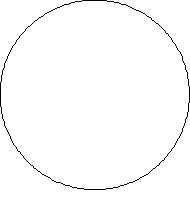Two mathematical objects are said to be homotopic if one can be continuously deformed into the other. For example, the real line is homotopic to a single point, as is
any tree. However, the circle is not contractible,
but is homotopic to a solid torus. The basic version of homotopy is between maps.
Two maps
and
are homotopic if there is
a continuous map
such that
and
.

Whether or not two subsets are homotopic depends on the ambient space. For example, in the plane, the unit circle is homotopic to a point, but not in the punctured
plane . The puncture can be thought of
as an obstacle.
However, there is a way to compare two spaces via homotopy without ambient spaces. Two spaces
and
are homotopy equivalent if there are
maps
and
such that the composition
is homotopic to the identity
map of
and
is homotopic to the identity
map of
.
For example, the circle is not homotopic to a point, for then the constant map would
be homotopic to the identity map of a circle, which is impossible because they have
different Brouwer degrees.